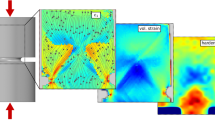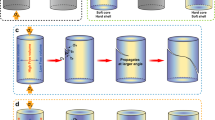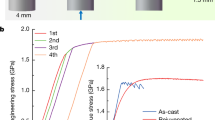Abstract
Metallic glasses, now that many compositions can be made in bulk1,2,3, are of interest for structural applications exploiting their yield stress and yield strain, which are exceptionally high for metallic materials4. Their applicability is limited by their near-zero tensile ductility resulting from work-softening and shear localization. Even though metallic glasses can show extensive local plasticity, macroscopically they can effectively be brittle, and much current research is directed at improving their general plasticity. In conventional engineering materials as diverse as silicate glasses and metallic alloys, we can improve mechanical properties by the controlled introduction of compressive surface stresses5,6,7. Here we demonstrate that we can controllably induce such residual stresses in a bulk metallic glass, and that they improve the mechanical performance, in particular the plasticity, but that the mechanisms underlying the improvements are distinct from those operating in conventional materials.
This is a preview of subscription content, access via your institution
Access options
Subscribe to this journal
Receive 12 print issues and online access
$259.00 per year
only $21.58 per issue
Buy this article
- Purchase on Springer Link
- Instant access to full article PDF
Prices may be subject to local taxes which are calculated during checkout




Similar content being viewed by others
References
Johnson, W. L. Bulk glass-forming metallic alloys: science and technology. Mater. Res. Soc. Bull. 24, 42–56 (1999).
Inoue, A. Stabilization of metallic supercooled liquid and bulk amorphous alloys. Acta Mater. 48, 279–306 (2000).
Wang, W. H., Dong, C. & Shek, C. H. Bulk metallic glasses. Mater. Sci. Eng. R 44, 45–89 (2004).
Ashby, M. F. & Greer, A. L. Metallic glasses as structural materials. Scr. Mater. 54, 321–326 (2006).
Gardon, R. in Elasticity and Strength in Glasses (eds Uhlmann, D. & Kreidl, N. J.) 145–216 (Glass: Science and Technology, Vol. 5, Academic, New York, 1980).
Zarzycki, J. Glasses and the Vitreous State 398–404 (Cambridge Univ. Press, Cambridge, 1991).
Evans, E. B. in Encyclopedia of Materials Science and Engineering Vol. 6, (ed. Bever, M. B.) 4187–4188 (Pergamon, Oxford, 1986).
Okazaki, Y. Loss deterioration in amorphous cores for distribution transformers. J. Magn. Magn. Mater. 160, 217–222 (1996).
Tejedor, M., Garcia, J. A., Carrizo, J., Elbaile, L. & Santos, J. D. Effect of residual stresses and surface roughness on coercive force in amorphous alloys. J. Appl. Phys. 91, 8435–8437 (2002).
Ritchie, R. O., Schroeder, V. & Gilbert, C. J. Fracture, fatigue and environmentally-assisted failure of a Zr-based bulk amorphous metal. Intermetallics 8, 469–475 (2000).
Aydiner, C. C. & Üstündag, E. Residual stresses in a bulk metallic glass cylinder induced by thermal tempering. Mech. Mater. 37, 201–212 (2005).
Aydiner, C. C. et al. Residual stresses in a bulk metallic glass—stainless steel composite. Mater. Sci. Eng. A 399, 107–113 (2005).
Kim, Y. C., Fleury, E., Lee, J. C. & Kim, D. H. Origin of the simultaneous improvement of strength and plasticity in Ti-based bulk metallic glass matrix composites. J. Mater. Res. 20, 2474–2479 (2005).
Spaepen, F. A microscopic mechanism for steady state inhomogeneous flow in metallic glasses. Acta Metall. 25, 407–415 (1977).
Bei, H., Xie, S. & George, E. P. Softening caused by profuse shear banding in a bulk metallic glass. Phys. Rev. Lett. 96, 105503 (2006).
Lowhaphandu, P. & Lewandowski, J. J. Fracture toughness and notched toughness of bulk amorphous alloy: Zr-Ti-Ni-Cu-Be. Scr. Mater. 38, 1811–1817 (1998).
Suresh, S. & Giannakopoulos, A.E. A new method for estimating residual stresses by instrumented sharp indentation. Acta Mater. 46, 5755–5767 (1998).
Lowhaphandu, P., Montgomery, S. L. & Lewandowski, J. J. Effects of superimposed hydrostatic pressure on flow and fracture of a Zr-Ti-Ni-Cu-Be bulk amorphous alloy. Scr. Mater. 41, 19–24 (1999).
Carlsson, S. & Larsson, P.-L. On the determination of residual stress and strain fields by sharp indentation testing. Part I: Theoretical and numerical analyses. Acta Mater. 49, 2179–2191 (2001).
Chen, X., Yan, J. & Karlsson, A. M. On the determination of residual stress and mechanical properties by indentation. Mater. Sci. Eng. A 416, 139–149 (2006).
Krishnanand, K. D. & Cahn, R. W. Recovery from plastic deformation in a Ni/Nb alloy glass. Scr. Metall. 9, 1259–1261 (1975).
Conner, R. D., Johnson, W. L., Paton, N. E. & Nix, W. D. Shear bands and cracking of metallic glass plates in bending. J. Appl. Phys. 94, 904–911 (2003).
Das, J. et al. Work-hardenable ductile bulk metallic glass. Phys. Rev. Lett. 94, 205501 (2005).
Yang, B., Riester, L. & Nieh, T. G. Strain hardening and recovery in a bulk metallic glass under nanoindentation. Scr. Mater. 54, 1277–1280 (2006).
Zhang, Z. F., Zhang, H., Pan, X. F., Das, J. & Eckert, J. Effect of aspect ratio on the compressive deformation and fracture behaviour of Zr-based bulk metallic glass. Phil. Mag. Lett. 85, 513–521 (2005).
Klein, C. A. How accurate are Stoney’s equation and recent modifications. J Appl. Phys. 88, 5487–5489 (2000).
Acknowledgements
Y.Z. acknowledges support from Trinity College Cambridge and the Schlumberger Cambridge Trust, W.H.W. from the National Science Foundation of China and A.L.G. from the European Commission under MCRTN contract ‘Ductile bulk metallic glass composites’.
Author information
Authors and Affiliations
Contributions
Y.Z. was responsible for the experimental work, W.H.W. for supervising sample preparation, A.L.G. for supervising structural characterization and mechanical testing, and all authors for interpretation of results.
Corresponding author
Ethics declarations
Competing interests
The authors declare no competing financial interests.
Rights and permissions
About this article
Cite this article
Zhang, Y., Wang, W. & Greer, A. Making metallic glasses plastic by control of residual stress. Nature Mater 5, 857–860 (2006). https://doi.org/10.1038/nmat1758
Received:
Accepted:
Published:
Issue Date:
DOI: https://doi.org/10.1038/nmat1758
This article is cited by
-
Rejuvenation engineering in metallic glasses by complementary stress and structure modulation
NPG Asia Materials (2023)
-
Comprehensive thermal analysis of a high stability Cu–Zr–Al bulk metallic glass subjected to high-pressure torsion
Journal of Thermal Analysis and Calorimetry (2023)
-
Multiscale simulation and experimental measurements of the elastic response for constructional steel
Scientific Reports (2022)
-
Constitutive modeling of mechanical behaviors in gradient nanostructured alloys with hierarchical dual-phased microstructures
Acta Mechanica (2022)
-
Using the Reflection Ellipsometry to Detect the Stress for the Gold Coating Reflection Mirrors
Microgravity Science and Technology (2022)



